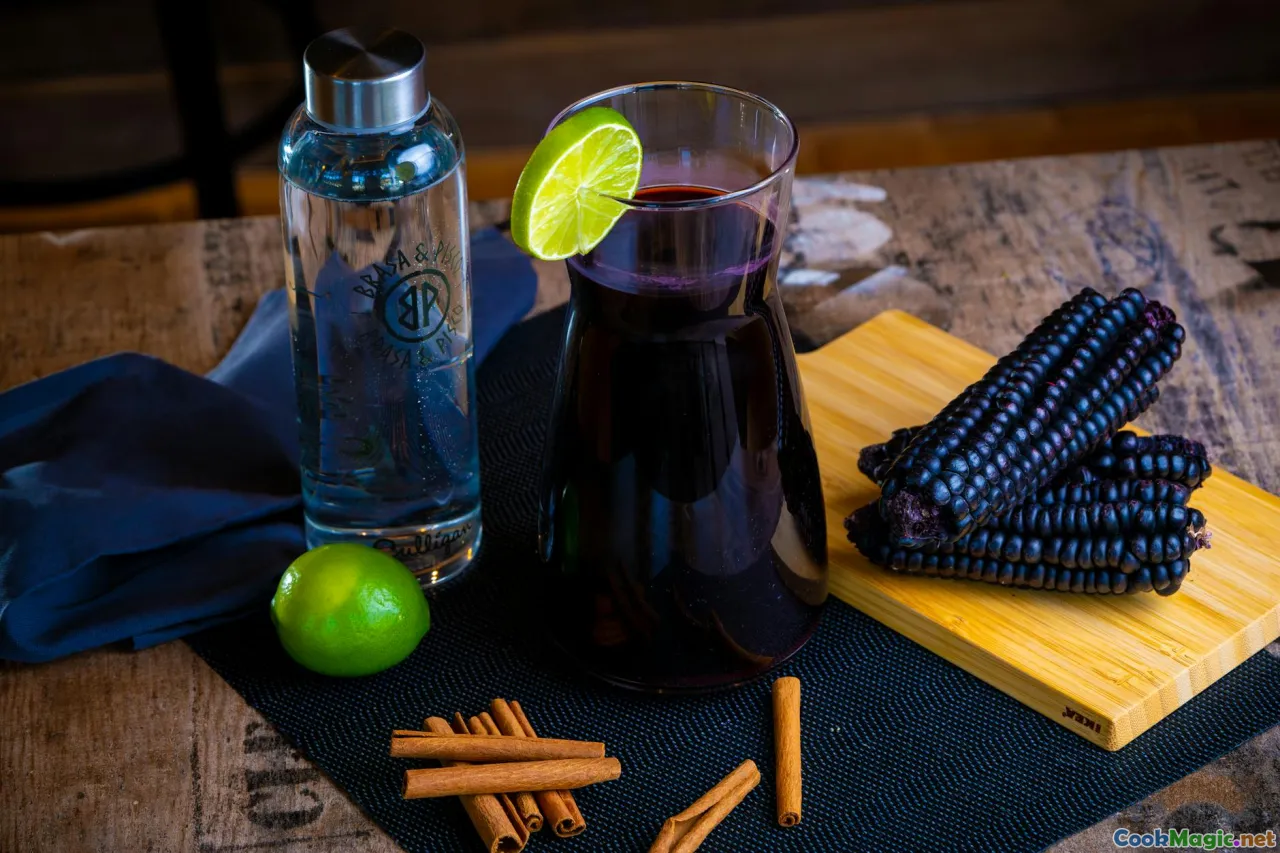
温かいトウモロコシのアトルとシナモンの渦巻き
(Warm Corn Atol with Cinnamon Swirls)
(0 レビュー)材料
-
3 cups フレッシュコーンの粒
(約5〜6本のスイートコーンの耳または冷凍して解凍したもの)
-
4 cups 全乳
(ヴィーガンバージョンにはオートミルクまたはアーモンドミルクに置き換えることができます)
-
1/2 cup ブラウンシュガー
(お好みに合わせて調整してください。ピロンシージョやパネラを使えます)
-
2 sticks シナモンスティック
(芳香の温かさを加える)
-
1 cup 水
(トウモロコシのピューレを作るために)
-
1/4 teaspoon 塩
(風味を引き立てる)
-
1 teaspoon バニラエキス
(味の深みのためのオプションの一手)
-
1 teaspoon シナモンパウダー
(提供する前に振りかけるために)
(約5〜6本のスイートコーンの耳または冷凍して解凍したもの)
(ヴィーガンバージョンにはオートミルクまたはアーモンドミルクに置き換えることができます)
(お好みに合わせて調整してください。ピロンシージョやパネラを使えます)
(芳香の温かさを加える)
(トウモロコシのピューレを作るために)
(風味を引き立てる)
(味の深みのためのオプションの一手)
(提供する前に振りかけるために)
栄養
- 分量: 4
- 1人分の量: 1マグカップ(250ml)
- Calories: 230 kcal
- Carbohydrates: 0 g
- Protein: 7 g
- Fat: 4 g
- Fiber: 3 g
- Sugar: 20 g
- Sodium: 120 mg
- Cholesterol: 10 mg
- Calcium: 175 mg
- Iron: 0.5 mg
作り方
-
1 - コーンを準備する:
新鮮なトウモロコシを使う場合は、穂をむき、鋭いナイフで粒を切り取ります。粒を取っておきます。
-
2 - コーンをブレンド:
ブレンダーにトウモロコシの粒と1カップの水を入れます。非常になめらかになるまでピューレ状にし、必要に応じて側面の材料をこそげ取ります。
-
3 - 混合物を濾す:
コーンの混合物を細かい網またはチーズクロスでこし、液体と固形物を分けてシルキーな食感を得ます。
-
4 - 材料を組み合わせる:
濾した混合物を大きな鍋に注ぎます。牛乳、シナモンスティック、ブラウンシュガー、塩を加えます。よくかき混ぜてください。
-
5 - アトルを煮る:
中火から弱火にして、絶えずかき混ぜながら混合物を優しく煮立たせます。焦げ付かないように注意しながら、 atolが濃厚でクリーミーな状態になるまで調理を続けてください。
-
6 - 仕上げて出す:
火から下ろし、シナモンスティックを取り除き、使用する場合はバニラエッセンスを混ぜます。マグカップで熱いうちに提供し、ひとつまみの挽き肉シナモンを振りかけてください。
新鮮なトウモロコシを使う場合は、穂をむき、鋭いナイフで粒を切り取ります。粒を取っておきます。
ブレンダーにトウモロコシの粒と1カップの水を入れます。非常になめらかになるまでピューレ状にし、必要に応じて側面の材料をこそげ取ります。
コーンの混合物を細かい網またはチーズクロスでこし、液体と固形物を分けてシルキーな食感を得ます。
濾した混合物を大きな鍋に注ぎます。牛乳、シナモンスティック、ブラウンシュガー、塩を加えます。よくかき混ぜてください。
中火から弱火にして、絶えずかき混ぜながら混合物を優しく煮立たせます。焦げ付かないように注意しながら、 atolが濃厚でクリーミーな状態になるまで調理を続けてください。
火から下ろし、シナモンスティックを取り除き、使用する場合はバニラエッセンスを混ぜます。マグカップで熱いうちに提供し、ひとつまみの挽き肉シナモンを振りかけてください。
温かいトウモロコシのアトルとシナモンの渦巻き :の詳細
Atol de Elote con Canela: The Warmth of Salvadoran Tradition
Introduction
Atol de Elote con Canela, or Sweet Corn Atol with Cinnamon, is a beloved traditional beverage enjoyed in Central America, heralding its roots especially in El Salvador and Guatemala. Known for its soothing, creamy texture and subtly sweet corn essence beautifully accented by cinnamon, it is more than just a drink—it is an experience that conjures comfort, cultural memory, and celebration.
History and Cultural Significance
The atol, or "atole" as mispronounced elsewhere, dates back to pre-Columbian times. Maize (corn) was not just the base of the Mesoamerican diet but was believed to be a sacred crop, the very substance from which the gods created humanity in Mayan legend. The indigenous peoples would grind fresh corn and sweeten the result with local sugars or honey, sometimes flavoring with vanilla, spices, or cacao. In the colonial era, milk and cinnamon were introduced by the Spanish, giving us the rich, luscious version beloved today.
Atol de Elote is especially evocative during holidays and festivities. It’s commonly found steaming on market carts in the early morning or late evening, ladled into clay mugs to chase away the chill of a rainstorm. During celebrations—whether the vibrant Fiestas Agostinas, November’s Día de los Muertos, or Christmas—it’s both comfort and celebration in a cup.
Unique Aspects and Variations
The unique aspect of atol de elote lies in its creamy but delicate texture—the result of straining blended corn into a silky base. Milk marries with corn’s natural sweetness, while cinnamon provides a universally appealing spiciness that's both warming and aromatic. Brown sugar or unrefined panela/piloncillo add caramel-like notes you can adjust to your preference.
Unlike rice-based or chocolate atoles, Atol de Elote’s golden color and floral corn aroma bridge the old with the new: indigenous ingredients meet colonial flavorings. Modern cooks may use blenders and fine mesh sieves for ease, but the heart of the recipe remains unchanged for centuries.
Tips & Personal Notes
- For Vegan Versions: Substitute plant-based milks like oat or almond. The beverage stays lovely and creamy whether traditional or vegan.
- Sweeteners: While brown sugar is common, try mashed sweet plantain or maple syrup for a depth of flavor.
- Serving: Always stir the bottom before ladling out, as the corn solids can settle. Serve with traditional Salvadoran pan dulce (sweet bread) or cookies—they are made for each other.
- Shelf Life: It’s best consumed warm and fresh. Leftovers thicken as they cool; add a little milk when reheating if desired.
- Personal Touch: When I traveled through El Salvador, my fondest breakfasts began in a bustling market beneath a corrugated tin roof, hands clasped around a simple ceramic mug of atol, its wiry vapors perfumed by cinnamon. It was a drink that whispered stories across centuries and communities.
Conclusion
In all, Atol de Elote con Canela is more than a recipe; it’s the project of tradition—passed from abuela to grandchild, shared with friends, and woven into the rhythms of daily Salvadoran life. Making it is a sensory journey from kernel to cup, echoing sustenance, celebration, and care in each warming sip. Whether you are tasting it anew or reviving childhood memories, this easy recipe nurtures both body and culture, uniting you with the hearths of Central America wherever you are.



















